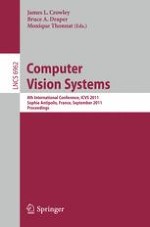2011 | Buch
Computer Vision Systems
8th International Conference, ICVS 2011, Sophia Antipolis, France, September 20-22, 2011. Proceedings
herausgegeben von: James L. Crowley, Bruce A. Draper, Monique Thonnat
Verlag: Springer Berlin Heidelberg
Buchreihe : Lecture Notes in Computer Science
